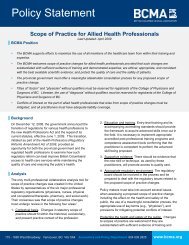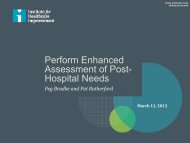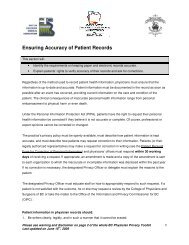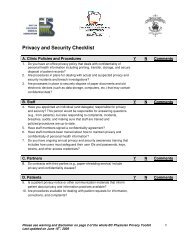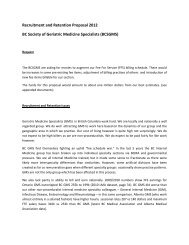Doctors Today and Tomorrow - British Columbia Medical Association
Doctors Today and Tomorrow - British Columbia Medical Association
Doctors Today and Tomorrow - British Columbia Medical Association
Create successful ePaper yourself
Turn your PDF publications into a flip-book with our unique Google optimized e-Paper software.
Key Considerations<br />
No perfect methodology exists for forecasting physician supply. Simulating future physician resources is not an exact<br />
science <strong>and</strong> the results will never be completely accurate. Nevertheless, the value of physician resource projections is<br />
to identify the current <strong>and</strong> emerging trends to which policymakers need to respond. In BC, the methodologies of using<br />
simple head counts <strong>and</strong> utilization forecasting can be strengthened by considering the following:<br />
1. As a complement to simple head counts, using robust FTE methodologies <strong>and</strong> functional<br />
specialty analyses would provide a more accurate depiction of physician supply.<br />
The use of simple head counts for analysis <strong>and</strong> planning, as already stated, implies that all physicians are equal<br />
in terms of their capacity to provide services. However, the “service output” varies among physicians because of<br />
different workloads <strong>and</strong> practice activities. Physicians may be semi-retired, working part-time, or participating in<br />
a mix of clinical, teaching, administrative, <strong>and</strong> research activities within their practice. The conventional approach<br />
to measuring service output (e.g., clinical billings) may not be comprehensive enough in light of the growing<br />
shift toward alternative delivery models, alternative payment mechanisms, <strong>and</strong> outcomes-based practice. In<br />
the future, FTE measurements should use flexible data collection methodologies to obtain information on a<br />
variety of activities, regardless of mode of payment, <strong>and</strong> new service output measures that relate to quality <strong>and</strong><br />
outcomes.<br />
As well, if effective workforce planning is to occur, then the services that physicians actually provide must be<br />
identified. Reports show that there are significant variations in scope of practice among GPs <strong>and</strong> specialists;<br />
fewer GPs are providing obstetrics, anesthesia, advanced procedural skills services, <strong>and</strong> hospital inpatient<br />
care, <strong>and</strong> some physicians are providing services in a subspecialty within their certified specialty. To determine<br />
how much of physicians’ work time is devoted to direct patient care <strong>and</strong> the types of care they are providing,<br />
functional specialty analyses must be carried out.<br />
2. A provincial analytical framework is needed to ensure that forecasting methods incorporate<br />
needs-based planning.<br />
Current physician workforce planning is largely based on utilization patterns, the supply of physicians, <strong>and</strong><br />
budgetary capacity rather than on population health needs. The recurrent cycles of over- <strong>and</strong> undersupply of<br />
physician resources can be traced, in part, to the shortcomings of utilization-based planning. Developing the<br />
capacity for needs-based planning requires a provincial analytical framework to direct <strong>and</strong> organize decision<br />
making, <strong>and</strong> more comprehensive <strong>and</strong> st<strong>and</strong>ardized data (see below).<br />
3. Effective physician workforce planning requires accurate, accessible, <strong>and</strong> st<strong>and</strong>ardized data.<br />
Currently, efforts to reconcile physician databases across the province are limited. As a result, it may be difficult<br />
to obtain an accurate number of practising physicians, which in turn leads to inaccurate supply projections.<br />
Regardless of the forecasting methodology implemented, measurement tools must be able to consistently<br />
quantify the supply of physicians, <strong>and</strong> consistently evaluate historical, current, <strong>and</strong> future supply projections in<br />
the province. Further developments in forecasting methodologies will also benefit from more comprehensive<br />
data on factors <strong>and</strong> variables, such as demographics <strong>and</strong> disease prevalence; valid physician workforce<br />
indicators, such as FTEs <strong>and</strong> functional specialities; <strong>and</strong> the identification of appropriate evaluation outcomes of<br />
forecasting methodologies used.<br />
<strong>Doctors</strong> <strong>Today</strong> <strong>and</strong> <strong>Tomorrow</strong> – The Physician Workforce: Planning for the future 9



